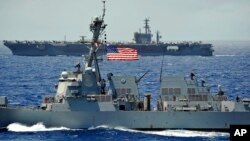China for the first time is sending multiple ships to a U.S.-led international maritime drill known as RIMPAC, or Rim of Pacific exercise . China’s official media describes the trip as a venture “deep into the tiger’s den.” Absent from this year’s participant list is Russia.
Forty-seven ships, along with six submarines, more than 200 aircraft and 25,000 personnel, will participate in this year’s RIMPAC exercise.
According to Chinese media, four ships from People's Liberation Army Navy - including a guided missile destroyer, a guided missile escort ship, a multi-purpose supply ship and a medical ship known as the Peace Arc - left Chinese ports Monday. China is also sending two helicopters, a team of divers and a special forces unit, for a total of 1,100 members of its military.
They are heading towards Guam where the ships will meet with those from the United States, Singapore, Brunei and head together to Hawaii, where the exercises will take place from June 26 to August 1. More than 20 nations are expected to participate.
RIMPAC, started in 1971 and held every two years under the banner of the U.S. Pacific Fleet, is billed as the world’s largest multinational maritime exercise.
The last such exercise saw Russia participate for the first time, sending three ships. But Moscow is absent this year.
The U.S. describes RIMPAC as a “unique training opportunity” that helps participants foster and sustain cooperative relationships “that are critical to ensuring the safety of sea lanes and security on the world’s oceans.”
China's official Xinhua news agency bills the participation as “an important military diplomacy mission” entrusted by the Central Military Commission and “an important step in putting into practice a new kind of Sino-U.S. and bilateral military-to-military relations.”
Xinhua gave the story prominent placement on its website, with pictures of the ships highlighted and a written report calling the journey a venture “deep into the tiger’s den, putting our self-confidence on display."
Scott Harold, Associate Political Scientist at the RAND Corporation, says the headline reveals the underlying complexity in bilateral relations between the United States and China. He said the Xinhua headline is an indication of the “contentious nature of this engagement. What we’re seeing is probably a result of that strategic mistrust on the part of some in Beijing.”
Critics of the Obama administration’s “pro-dialogue” approach towards China and the Chinese military doubt China's participation in RIMPAC will lead to meaningful transparency or cooperation from Beijing.
Rick Fisher, a Senior Fellow with the Washington-based International Assessment and Strategy Center, worries that having the Chinese ships and personnel at the exercises offers Beijing “an intelligence bonanza, as it will be able to watch how the U.S. Navy interacts with its allies, which could be most useful in the event of actual military incidents or conflict.”
Forty-seven ships, along with six submarines, more than 200 aircraft and 25,000 personnel, will participate in this year’s RIMPAC exercise.
According to Chinese media, four ships from People's Liberation Army Navy - including a guided missile destroyer, a guided missile escort ship, a multi-purpose supply ship and a medical ship known as the Peace Arc - left Chinese ports Monday. China is also sending two helicopters, a team of divers and a special forces unit, for a total of 1,100 members of its military.
They are heading towards Guam where the ships will meet with those from the United States, Singapore, Brunei and head together to Hawaii, where the exercises will take place from June 26 to August 1. More than 20 nations are expected to participate.
RIMPAC, started in 1971 and held every two years under the banner of the U.S. Pacific Fleet, is billed as the world’s largest multinational maritime exercise.
The last such exercise saw Russia participate for the first time, sending three ships. But Moscow is absent this year.
The U.S. describes RIMPAC as a “unique training opportunity” that helps participants foster and sustain cooperative relationships “that are critical to ensuring the safety of sea lanes and security on the world’s oceans.”
China's official Xinhua news agency bills the participation as “an important military diplomacy mission” entrusted by the Central Military Commission and “an important step in putting into practice a new kind of Sino-U.S. and bilateral military-to-military relations.”
Xinhua gave the story prominent placement on its website, with pictures of the ships highlighted and a written report calling the journey a venture “deep into the tiger’s den, putting our self-confidence on display."
Scott Harold, Associate Political Scientist at the RAND Corporation, says the headline reveals the underlying complexity in bilateral relations between the United States and China. He said the Xinhua headline is an indication of the “contentious nature of this engagement. What we’re seeing is probably a result of that strategic mistrust on the part of some in Beijing.”
Critics of the Obama administration’s “pro-dialogue” approach towards China and the Chinese military doubt China's participation in RIMPAC will lead to meaningful transparency or cooperation from Beijing.
Rick Fisher, a Senior Fellow with the Washington-based International Assessment and Strategy Center, worries that having the Chinese ships and personnel at the exercises offers Beijing “an intelligence bonanza, as it will be able to watch how the U.S. Navy interacts with its allies, which could be most useful in the event of actual military incidents or conflict.”








